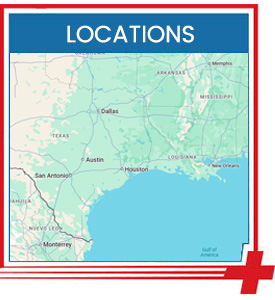Pediatric Fever Treatment Doctor Q&A
A fever indicates that the body is fighting and overcoming an infection properly; however, there are times at which a fever could indicate a cause for concern. If your child’s fever is too high, along with other symptoms such as fits, rashes, and infection, it is best to see a doctor immediately. For more information, contact us or join the virtual line. We have convenient locations to serve you in Bulverde Rd San Antonio TX, Bastrop TX, Alamo Ranch San Antonio TX, La Grange TX, Leon Springs San Antonio TX, New Braunfels TX, Potranco Road San Antonio TX, Dripping Springs TX, Lemon Creek Boerne TX, and Belle Chasse LA.


Table of Contents:
When should I worry about a pediatric fever?
What is considered a pediatric fever?
When should I take my child to the hospital for a fever?
How do you bring a child’s fever down?
It is common for doctors to see worried parents bring in feverish children for treatment. In certain cases of fever, prompt medical treatment is very important. In most cases, fevers are not harmful and can even be beneficial since they fight infections naturally.
A fever indicates that the body is fighting and overcoming an infection properly. As a result of a chemical reaction, your body raises its core temperature to prevent the replication of bad bacteria and viruses. Due to the fact that bacteria and viruses can only reproduce when certain conditions are met, this method of stopping their reproduction is very effective.
It is most common for kids to get fevers as a result of viruses. Especially in daycares and preschools, where viruses spread easily, young children may have seven to ten viral illnesses with a fever each year. Bacteria is the second most common source of infection. Viruses and bacterial infections can both cause fevers.
A fever in a very young child – especially one under three months old – can be concerning. In the early stages of their development, their immune systems are still developing, making them at risk of severe infections when they have a fever.
A fever in a preschooler or school-age child is rarely of concern to pediatricians unless it lasts for four days or more. You may notice symptoms such as listlessness, irritability, coughing, or pain while urinating. Your child’s behavior can give you important indications concerning the seriousness of the fever.
Although 98.6 degrees Fahrenheit is considered a “normal” body temperature, don’t panic if your child’s temperature climbs higher. It is normal for everyone’s temperature to fluctuate throughout the day. Additionally, it can vary depending on the person’s age, level of activity, and other factors.
Depending on the type of thermometer you use, your child’s fever may be defined differently. It is possible to get different levels of accuracy with different types of thermometers. Talk to a pediatric care provider for more information on what is considered a pediatric fever on different thermometers.
Temperatures over 100.4 degrees Fahrenheit are considered fevers in infants less than 2 months old. In addition, if your newborn’s temperature is under 96 degrees Fahrenheit, you should call your doctor. You should take your newborn to the emergency room or urgent care clinic immediately if they have an abnormal temperature.
Fever is defined as a temperature greater than 101.5 degrees Fahrenheit in babies and children older than 3 months. If your child’s temperature reaches 102.2 degrees Fahrenheit or higher, call your doctor.
The majority of fevers disappear within a couple of days. If the fever lasts for more than four days, contact your doctor. You should consult a doctor immediately if your child has vomiting or diarrhea, an earache, severe abdominal pain, a headache, a stiff neck, a sore throat, difficulty breathing, pain when urinating, swollen joints, or other localized pains.
If your child has a high temperature, acetaminophen can help. There will be a dose listed on the label if they’re older than 2. Your doctor can tell you how much to give them if they’re younger. If your child is at least 6 months old, you can also use ibuprofen.
If you want to make them feel better, there are many things you can do. Make sure they’re kept in a moderate-temperature room with a cool compress on their head. Ensure that they are dressed in one layer of light clothing and that they have a blanket to keep them warm. Alternatively, you can give them a lukewarm sponge bath to cool them off. Be sure they drink a lot of fluids as well. And don’t be afraid to bring them to a pediatric fever treatment doctor if you have any concerns.
If your child’s fever is not getting under control, come to Fast Aid Urgent Care. We serve patients from Bulverde Rd San Antonio TX, Windcrest TX, Selma TX, Bastrop TX, Paige TX, Smithville TX, Alamo Ranch San Antonio TX, Leon Valley TX, Helotes TX, La Grange TX, Rabbs Prairie TX, Halsted TX, Leon Springs TX, Fair Oaks Ranch TX, Cross Mountain TX, New Braunfels TX, Hunter TX, Zorn TX, Potranco Road San Antonio TX, Rio Medina TX, Rolling Oaks Estates TX, Dripping Springs, TX, Saddletree Ranch TX, Belterra TX, Lemon Creek Boerne TX, Scenic Oaks TX, Fair Oaks Ranch TX, Belle Chasse LA, Timberlane LA, Woodmere LA, and surrounding areas.

Additional Services You May Need
▸ Urgent Care
▸ Walk-in Family Care
▸ Children’s Health
▸ Sports Physicals
▸ DOT Physicals
▸ Pediatric Urgent Care
▸ Immunization

Additional Services You May Need
▸ Urgent Care
▸ Walk-in Family Care
▸ Children’s Health
▸ Sports Physicals
▸ DOT Physicals
▸ Pediatric Urgent Care
▸ Immunization





